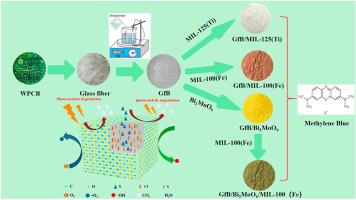Efficient recycling of glass fibers from waste printed circuit boards using metal-organic framework composites for photocatalytic degradation
引用次数: 0
Abstract
In recent years, the disposal of waste printed circuit boards (WPCBs) has emerged as an increasingly serious issue, particularly concerning the non-metallic powder generated during metal recovery, which poses a significant challenge to the utilization of e-waste resources. Furthermore, numerous technical defects are associated with this process. A systematic method is presented for preparing glass fiber ball bundles (GfBs), which incorporate a variety of metal-organic frameworks (MOFs) to create GfB/MIL-125 (Ti), GfB/MIL-100 (Fe), GfB/Bi2MoO6, and GfB/Bi2MoO6/MIL-100 (Fe) process systems. This approach aims to increase the efficiency of recycling glass fibers from the non-metallic powders of WPCBs. This study aims to investigate the photocatalytic degradation performance of composite materials comprising glass fibers loaded with MOFs, specifically GfB/MIL-100(Fe), GfB/Bi2MoO6, and GfB/Bi2MoO6/MIL-100(Fe), on model wastewater containing the organic compound methylene blue (MB). These findings indicate that the composites exhibited high photocatalytic efficiency and good reusability. The synthesized MOF composites achieved photocatalytic degradation of 100 mL of a 50 mg/L MB solution, reaching up to 96% degradation in 3 h, with a residual removal rate of 85% after 5 cycles. This study provides novel insights into the recycling of non-metallic materials from waste circuit boards and the development of environmentally friendly photocatalysts.

利用金属-有机框架复合材料进行光催化降解,有效回收废弃印刷电路板中的玻璃纤维
近年来,废旧印刷电路板(wpcb)的处理已成为一个日益严重的问题,特别是金属回收过程中产生的非金属粉末,对电子垃圾资源的利用提出了重大挑战。此外,许多技术缺陷与此过程相关。提出了一种制备玻璃纤维球束(GfBs)的系统方法,该方法包含多种金属有机框架(MOFs),以创建GfB/MIL-125 (Ti), GfB/MIL-100 (Fe), GfB/Bi2MoO6和GfB/Bi2MoO6/MIL-100 (Fe)工艺体系。该方法旨在提高从wpcb的非金属粉末中回收玻璃纤维的效率。本研究旨在研究由玻璃纤维组成的mof负载复合材料,特别是GfB/MIL-100(Fe), GfB/Bi2MoO6和GfB/Bi2MoO6/MIL-100(Fe)对含有机化合物亚甲基蓝(MB)的模型废水的光催化降解性能。结果表明,该复合材料具有较高的光催化效率和良好的可重复使用性。合成的MOF复合材料对100 mL 50 mg/L的MB溶液进行光催化降解,3 h降解率达96%,循环5次后残留去除率达85%。本研究为废电路板非金属材料的回收利用和环境友好型光催化剂的开发提供了新的见解。
本文章由计算机程序翻译,如有差异,请以英文原文为准。
求助全文
约1分钟内获得全文
求助全文

 求助内容:
求助内容: 应助结果提醒方式:
应助结果提醒方式:


